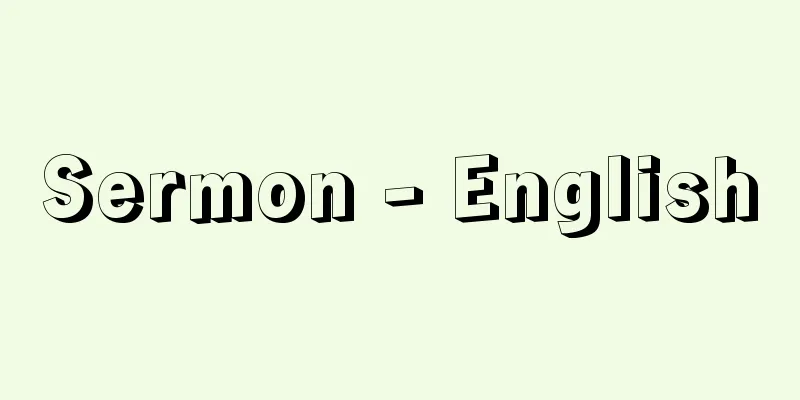Sermon - English

|
The basic elements that make up a religion include ideology, rituals, and religious organizations, but sermons are an important means of transmitting religious ideas orally, and are therefore considered the most important by clergy and religious organization members in many historical and world religions. In particular, while religious rituals serve to satisfy the sensory and emotional aspects of believers, sermons fulfill the role of satisfying the intellectual aspects of believers by conveying the ideological content of the religion to them. Written communication has a similar role to sermons, but oral sermons are an essential means of religious evangelism in that they appeal more directly to believers. In Buddhism, they have been called sekkyo, sermons, preaching, discussions, sermons, candidacy, hoza, etc. According to literature, sermons in Japanese Buddhism began with Prince Shotoku's lecture on the Sacred Worship Sutra in 598 (the 6th year of the reign of Empress Suiko). Later, in the Middle Ages, sermons that were simply teachings or explaining the contents of the scriptures, or in other words sermons, began to appear that had a musical or artistic quality, separate from sermons that simply gave doctrines or explained the contents of the scriptures. It was called the Angouin style or the Miidera style, and is said to have become the foundation for subsequent traditional Japanese performing arts. In Christianity, inheriting the tradition of Judaism, preaching has been as important as the Eucharist since the beginning of Christianity. In particular, Protestantism, which brought about the Protestant Reformation, rejected the external, formal, ritual-centered faith and emphasized an internal, rational faith, so sermons came to be considered particularly important. As a result, sermons have been studied and organized more systematically in Christianity than in other religions. In Christianity, sermons are divided into evangelistic sermons, expository sermons, thematic sermons, doctrinal sermons, ethical sermons, apologetic sermons, daily sermons, free sermons, etc., depending on the purpose, content, and form of the sermon. [Hoshino Hideki] [Reference] |Source: Shogakukan Encyclopedia Nipponica About Encyclopedia Nipponica Information | Legend |
|
宗教を構成する基本的要素として思想、儀礼、教団などがあげられるが、説教はその宗教思想を口頭で伝達するたいせつな手段として、多くの歴史宗教や世界宗教で、聖職者や教団人のもっとも重要視するところとなっている。 とくに、宗教儀礼が信者の感覚的、情緒的側面を満足させる働きを担っているのに対して、説教は、信者に対しその宗教のもつ思想内容を伝達することで知的な側面を充足させる、という役割を果たしているといえる。説教と同等の役割をもつものとして、文書による伝達があるが、口頭による説教はより直接的に信者に訴えることができるという意味で、宗教伝道には不可欠の手段となっている。仏教においては、説経、説法、説戒、談義、法談、勧化、法座、等々とよばれてきた。日本仏教における説教は文献上では、598年(推古天皇6)の聖徳太子の勝鬘経(しょうまんぎょう)についての講経に始まるという。その後、中世になると、単に教説を説いたり経典の内容を説明するという説教、いわば法話とは別に、音楽性や芸能性を帯びた説教が出現してきた。安居院(あんごいん)流、三井寺(みいでら)流とよばれ、その後の日本伝統芸能の基礎ともなったとされている。 キリスト教においては、ユダヤ教の伝統を引き継ぎ、すでにその発祥当初から説教は、聖餐(せいさん)とともに重要なものとなっていた。とくに宗教改革をもたらしたプロテスタントは、外面的、形式的な儀礼中心の信仰を否定し、内面的、合理的な信仰を強調したため、説教をとりわけ重要視することになった。そのため、キリスト教では、他宗教以上に説教が体系的に研究・整理されることになった。キリスト教では、説教の目的、内容、形態によって、伝道説教、講解説教、主題説教、教理的説教、倫理的説教、弁証論的説教、日課説教、自由説教などに分けられている。 [星野英紀] [参照項目] |出典 小学館 日本大百科全書(ニッポニカ)日本大百科全書(ニッポニカ)について 情報 | 凡例 |
>>: Red legged child - Sekkyakushi
Recommend
Gaucho - Gaucho (English spelling)
People who graze cattle in the grasslands (pampas...
Creangǎ, Ion
Born: March 1, 1837 in Humuresh, Moldova Died: Dec...
Coarse red clay pottery
…Red pottery is fired in a well-ventilated kiln u...
Ayaigasa (woven hat)
〘Noun〙 A hat made by weaving rush grass in a twill...
Reason - Jouri
The translation of naturalis ratio (Latin) and Na...
Sakamukae - Sakamukae
This is a ceremony to celebrate the safe return o...
Legong (English spelling)
A dance from Bali, Indonesia. It is a representati...
Torigo - Torigo
A child (kokata) in a temporary parent-child rela...
Whole Earth Catalog
...In addition, with the recent development of el...
Chebychev's inequality
If the random variable is x , the mean of x is μ, ...
Seigan Yanagawa
Year of death: September 2, 1858 (October 8, 1858)...
Joruri Memorial Service
Title of a Japanese piece. A combination of Kato-b...
Edo sect debate - Edo sect debate
... Later, when the Nichiren sect (Hokke sect) ro...
Aino Isthmus - Ainochikyo
...occupies the entire area of Shimabara City a...
King Anshan
…At that time, the Persians were moving south acr...









